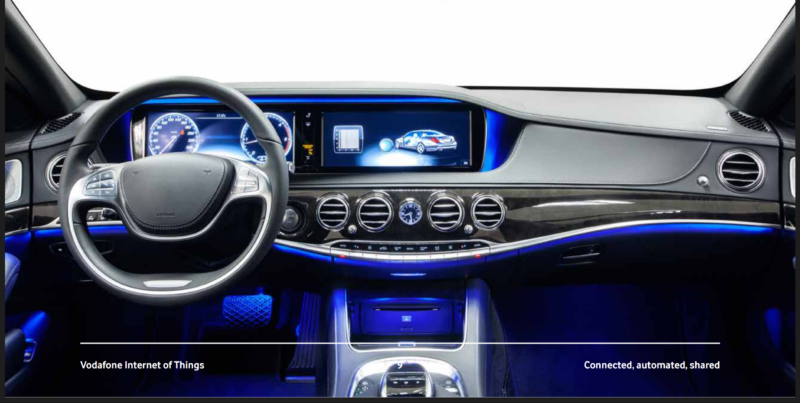The automotive industry is in the middle of a technological revolution. Ford Motor Company shunned the car shows to launch its new Kuga at Mobile World Congress.
Manufacturers like Volkswagen now run their own Silicon Valley labs. Despite being less than ten years old, Uber’s valuation beats that of long-established car manufacturers.
Vodafone in its latest Internet of Things report on the automotive sector explored three trends and technologies that are driving the digital transformation in automotive and transport. Connected car services, powered by the internet of things (IoT), help solve the diverse challenges facing transportation — such as reducing congestion and improving fleet management. Self-driving vehicles may seem like science fiction, but they’re closer than one might might think — both in consumer and commercial transportation.
Autonomous vehicles depend on ubiquitous sensing and connectivity from the IoT, and will accelerate innovation and transformation in business models, as reported by the Vodafone report. The highly digital nature of self-driving and connected vehicles will mean automotive manufacturers look to new partners from the technology sector.
The IoT connected car is enabling car manufacturers and service providers to move beyond traditional ownership and leasing toward new commercial models. In the new “car as a service” era, users will have improved choice of how they buy, rent, share and pool transportation services, particularly with autonomous vehicles in the mix, as noted in the Vodafone report.
Many of the service models will involve interconnections between multiple parties from different industries. A new ecosystem of insurers, regulators, retailers, fleet owners, public transport operators and technology companies will have to emerge. Collaboration will be critical to delivering the seamless mobility experiences that people and businesses expect, noted Vodafone.
Self-driving cars are highly connected as they engage with trusted authorities to identify, authenticate and authorise users and services with which they interact; other nearby vehicles and road infrastructure, to optimise traffic, safety and group behaviour; smart city infrastructure, to manage parking, tolls and other public services; Internet services, to report their location and gather navigation data, for example. They may even transmit video gathered by their 360-degree cameras to the local authority or law enforcement, acting as roving CCTV cameras to replace the fixed networks of cameras in existence. All of these connections will require ultra-reliable, high-performance connectivity.
Vodafone surveyed automotive industry figures in its 2015 M2M Barometer – 79 percent said that connected cars give them a way of offering customers better services. Crucially, these are ongoing services like periodic maintenance reminders, anti-theft tracking or monthly subscriptions for streaming entertainment, according to the Vodafone report. This is an opportunity to build a relationship with customers that previously disappeared the moment they drove off the forecourt.
Factory-connected cars generate a comprehensive flow of data into vehicle performance and real-world user behaviour. Some estimates suggest 25 GB of data can be generated per hour. Car manufacturers can use this data to improve their products and services, for example by using real-world driving data to develop more fuel-efficient engines.
Issuing over-the-air (OTA) updates to vehicle systems can correct faults while avoiding the huge cost associated with traditional recalls. 83 percent of automotive respondents in the 2015 M2M Barometer said that “minimising the impact of recalls is a compelling reason for connected cars”. The impact of this is hard to overstate: BMW managed to bug-fix 2.2 million vehicles over the air, the Vodafone report added.
Connected cars can inform dealers and drivers about problems and book vehicles in for upcoming services. 81 percent of those surveyed said that “retention by the car maker of aftermarket repairs is a compelling reason for connected cars”. Consumers benefit from greater convenience.
eCall in the EU, ERA-GLONASS in Russia, and other regional regulation is requiring that new vehicles come with connectivity to alert the emergency services in the event of an accident or breakdown. While many of these initiatives have been delayed, many OEMs have introduced their own schemes to get ahead. Standards bodies like the NHTSA in the US are actively setting standards for Vehicle to Vehicle (V2V) communications and autonomous vehicles.
Despite the benefits, there are barriers for businesses including from drivers who often resent the intrusion into their cabs, particularly where driving behaviour is monitored in-depth and where cameras are involved. The purchases of fleet management solutions can be delayed by lengthy vehicle replacement cycles, and the business case for investment may be weakened or deferred by periodic economic slowdowns or temporary drops in fuel costs.
To get the full benefit of investment, fleet management solutions need to be integrated into supply chain systems, ecommerce, HR systems, ERP, and business processes across the business. The greatest opportunities in the new connected world of transportation depend on multiple sectors working together to offer seamless services through radical new business models. Connectivity is opening up new business models for “car as a service.”
Using the foundation of the connected vehicle, and the autonomous vehicle after it, there is enormous potential to innovate in the business models that underpin the transportation system.
Tap-to-call services like Uber, car-pooling services like BlaBlaCar, and self-drive on-demand rental services like ZipCar are now familiar. As more vehicles get connected, and more of the infrastructure and services around transportation gets connected too (and as self-driving vehicles enter the mix), the possibilities are endless.
Opportunities get generated when consumers opt for a discount on their ride in a self-driving taxi if they interact with advertising on the dashboard. Retailers, taxi firms and other operators could pay consumers to carry goods or passengers with them in their owned cars, mixing personal and commercial journeys. Amazon Flex already does this in a number of US metro areas.
Using usage metering and remote unlocking, individuals could also rent out their cars during the day while they’re at work, instead of them sitting idle in the office car park or on the driveway. City authorities could charge variable prices for use of the city’s transport during peak traffic volumes — even allowing drivers to pay more in return for faster passage through congestion.
Connected car services are an important first step, but just as critical is working to forge non-traditional partnerships that benefit all parties, from the driver to the automotive company to the media, insurance and public sector bodies. These interconnections are fundamental to establishing the data flows and commercial models that will underpin a truly customer-centric mobility ecosystem.




